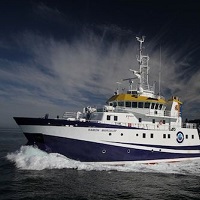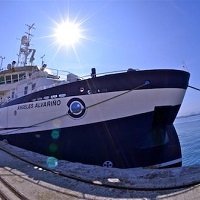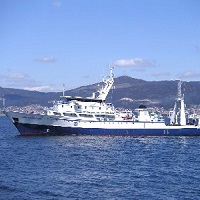Keyword
neuston net
32 record(s)
Type of resources
Categories
Topics
INSPIRE themes
Keywords
Contact for the resource
Provided by
Years
Formats
Status
-

Multidisciplinary cruise: anchored tools, sampling physical and chemical variables that will: - Study thermohaline characteristics, kinematics, dynamics and biology of the eastern half of the Gulf of Cadiz. - Study of carbon fluxes between the Atlantic and Mediterranean. - Establish relationships between climate, hydrology and hydrodynamics and the early stages of development of the species associated with the platform, with emphasis on species of commercial interest in a space/time. - Provide data to feed global and regional numerical models. - Generate and distribute a database for the evolution of the marine climate and its resources.
-

The main aim of the Triennial surveys is to estimate the spawning stock biomass of mackerel and horse mackerel applying the Annual and Daily Egg Production Method (AEPM and DEPM). The method relates the number of freshly spawned eggs found in the water column to the number of female having produced these eggs. Knowing the fecundity of the females and the sex ratio provides an estimate for the spawning-stock Biomass. In the frame of the ICES WGMEGS,AZTI is in charge of sampling the area of the Bay of Biscay. Sampling consist in collecting plankton samples to identify and stage the mackerel and horse mackerel eggs. Environmental parameters: At each station profile of sea temperature and salinity are recorded.
-

The main aim of the Triennial surveys is to estimate the spawning stock biomass of mackerel and horse mackerel applying the Annual and Daily Egg Production Method (AEPM and DEPM). The method relates the number of freshly spawned eggs found in the water column to the number of female having produced these eggs. Knowing the fecundity of the females and the sex ratio provides an estimate for the spawning-stock Biomass. In the frame of the ICES WGMEGS,AZTI is in charge of sampling the area of the Bay of Biscay. Sampling consist in collecting plankton samples to identify and stage the mackerel and horse mackerel eggs. Environmental parameters: At each station profile of sea temperature and salinity are recorded.
-

The main aim of the Triennial surveys is to estimate the spawning stock biomass of mackerel and horse mackerel applying the Annual and Daily Egg Production Method (AEPM and DEPM). The method relates the number of freshly spawned eggs found in the water column to the number of female having produced these eggs. Knowing the fecundity of the females and the sex ratio provides an estimate for the spawning-stock Biomass. In the frame of the ICES WGMEGS,AZTI is in charge of sampling the area of the Bay of Biscay. Sampling consist in collecting plankton samples to identify and stage the mackerel and horse mackerel eggs. Environmental parameters: At each station profile of sea temperature and salinity are recorded.
-

The ECOTRANS oceanographic-fishing cruises will cover the following objectives: i) Sampling plankton (micro and mesozooplankton); ii) Sampling larvae of selected pelagic fish and iii) Trawl sampling (demersal) and bird census to determine the species and functional groups biomass and the trophic ecology of small pelagic fish, hake, monkfish and sharks at the NW Mediterranean ecosystem. The cruise (15 days of duration) will be conducted during the spawning period of the sardine (winter) in order to get their larvae.
-

Multidisciplinary cruise: sampling physical and chemical variables that will: - Study thermohaline characteristics, kinematics, dynamics and biology of the eastern half of the Gulf of Cadiz. - Study of carbon flows between the Atlantic and Mediterranean watershed. - Establish relationships between climate, hydrology and hydrodynamics and the early stages of development of the species associated with the platform, with emphasis on species of commercial interest in a space/time. - Provide data to feed global and regional numerical models. - Generate and distribute a database for the evolution of the marine climate and its resources.
-

Conducting systematic sampling contemplated within the research project IEO oceanographic time series data in the Gulf of Cadiz.
-

The main aim of the Triennial surveys is to estimate the spawning stock biomass of mackerel and horse mackerel applying the Annual and Daily Egg Production Method (AEPM and DEPM). The method relates the number of freshly spawned eggs found in the water column to the number of female having produced these eggs. Knowing the fecundity of the females and the sex ratio provides an estimate for the spawning-stock Biomass. In the frame of the ICES WGMEGS,AZTI is in charge of sampling the area of the Bay of Biscay. Sampling consist in collecting plankton samples to identify and stage the mackerel and horse mackerel eggs. Environmental parameters: At each station profile of sea temperature and salinity are recorded.
-

Multidisciplinary cruise: sampling physical and chemical variables that will: - Study thermohaline characteristics, kinematics, dynamics and biology of the eastern half of the Gulf of Cadiz. - Establish relationships between climate, hydrology and hydrodynamics and the early stages of development of the species associated with the platform, with emphasis on species of commercial interest in a space/time. - Provide data to feed global and regional numerical models. - Generate and distribute a database for the evolution of the marine climate and its resources.
-

The main objective is that students of MIOUCA become familiar with some of the techniques that can be used aboard a research vessel. To do this, aboard the "B / O Angeles Alvariño" of the Spanish Institute of Oceanography (IEO), students will perform a series of activities that will enable the characterization of the water column and seabed, from a point of view multidisciplinary and integrative (biological, physical, chemical and geological), along two radial one perpendicular to the Cape Trafalgar and another perpendicular to the Guadalquivir River. To obtain the information necessary to perform this study different sampling techniques will be used, and data acquisition and analysis, and ship with their own computers. In this way the campaign will contribute to a comprehensive education of students in the multidisciplinary study of an oceanic region, with the participation of teachers in different areas of knowledge.
 Catálogo de datos del IEO
Catálogo de datos del IEO